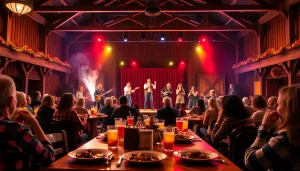Unraveling the Emotional Journey in the Movie Here: A Tale of Generational Connections

Understanding the Storyline of Here
Plot Overview of Here
The film Here is a profound exploration of the human experience filtered through the concept of place and memory. Centered around multiple families who inhabit the same home over the course of a century, it beautifully intertwines the lives, losses, and connection to the location that underpins their stories. The narrative traverses generations, reflecting how each era impacts the individuals living there, tackling the weight of history and the power of shared experiences. Ultimately, the film presents a poignant examination of familial bonds, illustrating how places hold memories that unite and divide us. Each character grapples with their past, searching for meaning in their lives as they navigate the complexities of love, legacy, and identity.
Characters That Define Here
Character development is pivotal in Here. The multi-generational cast serves not only to tell individual stories but also to create a collage of experiences that resonate across time. Key characters emerge as representations of different eras, embodying the prevailing sentiments of their respective periods.
For instance, a couple from the film’s early timeline may reflect the optimism of post-war America, while present-day characters might grapple with modern anxieties and the rapid pace of change. Their interactions form a tapestry of human connection—at times harmonious and at times strained, yet each thread contributes to the overarching narrative.
Additionally, children play significant roles, acting as bridges between generations. Their perspectives, often uninhibited and pure, provide fresh insights into the adult characters’ conflicts and motivations. As children grow, so too do their stories evolve, mirroring the narrative’s exploration of growth and continuity.
The Themes of Place and Memory in Here
At its core, Here celebrates the themes of place and memory, showing how our environments shape our identities. The house in the film acts as a character in itself; its walls hold the laughter, tears, and dreams of those who have lived within them. This sacred space encapsulates memories that span generations, ultimately questioning the concept of “home.” The narrative underscores how our connections to places linger long after we leave them, and how they continue to inform our choices and relationships.
Memory plays a significant role, influencing characters’ decisions and their understanding of self. The film delves into how memories can be both comforting and haunting. An old photograph, a piece of furniture, or even a simple walk through a familiar neighborhood can evoke powerful emotions, drawing characters into reflections that shape their present lives.
The Creative Force Behind Here
Director and Writer: Insights on the Vision for Here
Directed by the acclaimed Robert Zemeckis, Here is a testament to his storytelling prowess. Known for films that blend fantasy and reality, Zemeckis brings a unique touch to this narrative, harmonizing vibrant character arcs with thought-provoking themes. His vision delineates not just the storyline, but the emotional undercurrents that drive the characters.
Zemeckis co-wrote the screenplay alongside Eric Roth, crafting a script that pays homage to the source material while allowing for creative liberties essential in cinematic storytelling. Their collaborative process involved meticulous attention to character dynamics and the complexities of human emotion, ensuring that each line resonates authentically with the audience.
How Here Relates to Robert Zemeckis’ Legacy
The film Here is indicative of Zemeckis’ legacy, showcasing his enduring commitment to exploring human emotion through innovative cinematography and compelling storytelling. His earlier works, such as Forrest Gump and The Polar Express, paved the way for immersive narratives that blend technological advancement and rich character exploration.
In Here, Zemeckis applies similar techniques, employing cutting-edge visual effects to enhance storytelling while grounding the narrative in human experiences. The film feels both timeless and contemporary, reflecting the director’s ability to resonate with audiences across various demographics.
Adaptation from Graphic Novel to Film in Here
Adapted from a graphic novel, Here showcases the potential of transforming visual storytelling into a rich cinematic experience. The original graphic novel laid a strong foundation, filled with potent imagery and narratives, yet the film enhances these visual elements through dynamic cinematography and sound design.
The adaptation process involved careful consideration of the graphic novel’s themes while expanding character backstories and motivations to fit a feature-length format. This balance between the visual aesthetic and narrative depth is crucial to engage audiences who may be fans of the original material while also attracting new viewers.
Audience Reception and Critic Reviews of Here
Box Office Performance Expectations for Here
Considering the film’s pedigree, expectations for box office performance are notably high. With a star-studded cast featuring Tom Hanks and Robin Wright, paired with Robert Zemeckis’ directorial legacy, industry analysts anticipate a strong opening. The marketing strategy taps into nostalgia and emotional storytelling, appealing to audiences looking for heartfelt cinema amidst an array of blockbuster offerings.
Pre-release buzz is crucial, as positive early reviews and audience screenings often translate into sustained interest and box office success. The film’s thematic relevance in today’s world—the exploration of family and belonging—positions it well to resonate with diverse audiences.
Critical Acclaim: What Reviewers Say About Here
Critical acclaim has already begun to roll in from early screenings, with many reviewers praising the film for its emotional depth and character-driven storytelling. Critics note that Zemeckis successfully blends a rich emotional narrative with engaging visuals, resulting in a film that feels both relatable and profound.
Reviewers have highlighted the performances of the lead actors, complimenting their ability to convey complex emotions through subtle nuances. The interplay between Robin Wright and Tom Hanks, in particular, has been described as electric, encapsulating the very essence of connection and disconnection across generations.
Audience Reactions and Insights on Here
Initial audience reactions have reflected a deep emotional engagement with the film. Viewers have been particularly moved by the thematic exploration of nostalgia and connection, often recounting personal experiences that resonate with the story’s depiction of familial ties.
Social media has buzzed with discussions surrounding particular scenes and character arcs, indicating a film that not only entertains but incites reflection and conversation. This engagement often translates into grassroots word-of-mouth promotion, which can be pivotal for a film’s longevity in theaters.
The Cinematic Techniques Used in Here
Visual Storytelling in Here: Cinematography Techniques
Cinematography plays a vital role in shaping the emotional landscape of Here. The film employs various techniques to enhance storytelling—balanced compositions, dynamic camera movements, and lighting choices that reflect the mood of each scene. For instance, warm lighting may evoke feelings of nostalgia during flashback sequences, while darker tones can underscore themes of loss and struggle.
Moreover, the use of location as a character is amplified through meticulous shot selection, emphasizing the house’s presence in the characters’ lives. Close-ups draw viewers into intimate moments, fostering empathy and understanding of the characters’ internal conflicts.
Music and Sound Design Enhancing Here
The score of Here, composed by a renowned artist, complements the visual elements beautifully, enhancing the emotional resonance of pivotal scenes. Music becomes a storytelling device, amplifying the sentiment and guiding audience reactions without overshadowing the narrative. The intertwining of melodies with soundscapes further immerses viewers in the atmosphere and time period of each scene.
Sound design also plays a crucial role; subtle background noises can evoke memories or create a sense of familiarity and belonging that ties the audience closer to the characters’ experiences. By carefully orchestrating both music and sound elements, the film crafts a multi-layered auditory experience that lingers in viewers’ minds long after the credits roll.
Editing Choices That Shape the Narrative in Here
Editing in Here is a pivotal force that shapes pacing and narrative flow. The film employs non-linear storytelling, which allows viewers to perceive the characters’ histories alongside their present struggles. This technique keeps audiences engaged, urging them to piece together the narrative threads as they explore relationships shaped by time.
Transitional sequences seamlessly merge different timelines, supported by thoughtful cutting techniques that emphasize emotional beats and thematic coherence. Whether through flashbacks or character associations, the editing not only enhances storytelling but also reinforces the film’s exploration of memory and place.
Exploring the Legacy of Here
Comparative Analysis with Other Films by Zemeckis
A comparative analysis of Here with other notable films by Robert Zemeckis highlights recurring themes of connection, family, and the intricacies of time. His past works, including Forrest Gump and Cast Away, similarly reflect journeys through personal and collective histories.
With Here, Zemeckis revisits these themes, diving deeper into the emotional fabric of familial relationships and showcasing how the passage of time shapes identity. The director retains his hallmark storytelling style—melding humor and pathos—to connect with audiences on a personal level.
The Influence of Here on Future Filmmaking
As a culturally relevant work, Here may set the tone for a new wave of filmmaking that emphasizes character-driven narratives intertwined with social commentary. Its exploration of place as a character may inspire filmmakers to focus more on how environments shape human experiences, fostering a fresh approach to storytelling in future projects.
The film also serves as a reminder of the importance of memory in shaping both history and identity. Emerging filmmakers could take cues from Zemeckis’ techniques, utilizing non-linear narratives and rich character studies that invite audiences to reflect on their own experiences.
Fan Theories and Discussions Surrounding Here
As with any significant cinematic release, Here has sparked fan theories and discussions that delve into its themes and character motivations. Online forums and social media platforms are abuzz with analytical interpretations, with some viewers exploring how the generational dynamics reflect broader societal changes.
The film’s approach to intertwined fates has led to speculation about potential sequels or connected stories, as fans are eager to know more about the lives portrayed on screen. Such engagement speaks volumes about the film’s impact and resonance on audiences, establishing its place in cultural dialogues.







